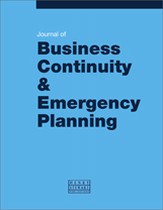Integrating pandemic flu response planning with business continuity planning at Johns Hopkins University Applied Physics Laboratory
Abstract
Pandemic response planning augments continuity planning and preparedness. This paper describes experiences in integrating pandemic response with business continuity planning at the Johns Hopkins University Applied Physics Laboratory. The paper discusses environmental triggers that provide a framework for specific actions, such as activating social distancing and work-at-home measures to be taken during a pandemic, and argues that having staff able to work at home is key to ensuring the organisation can reach the balance of supporting customers, caring for staff and staying solvent. To understand potential cash-flow problems, financial modelling is used to predict the impact of severe and more moderate pandemic influenza outbreaks. Lessons learned, suggestions for effective communications and a control structure are discussed, together with insights and strategies.
The full article is available to subscribers to the journal.
Author's Biography
Mary Lasky is Program Manager for Business Continuity Planning for the Johns Hopkins University Applied Physics Laboratory (JHU/APL). She leads the APL pandemic influenza response planning effort and coordinates the APL incident management team. Ms Lasky is the chair of the Pandemic Influenza Education and Communication Group for the Johns Hopkins Office of Critical Event Preparedness and Response (CEPAR), which is responsible for pandemic planning for the Hopkins Institutions. Ms Lasky is also the JHU/APL representative to the Community Emergency Response Network in Howard County, Maryland, and the co-chair for county-wide business continuity planning.
Citation
Lasky, Mary (2007, October 1). Integrating pandemic flu response planning with business continuity planning at Johns Hopkins University Applied Physics Laboratory. In the Journal of Business Continuity & Emergency Planning, Volume 2, Issue 1. https://doi.org/10.69554/SUXW3554.Publications LLP
